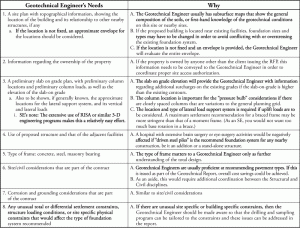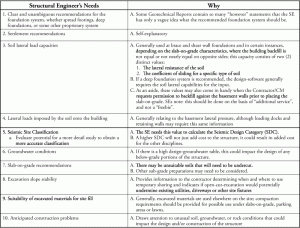Small Effort Yields Big Dividends
This article makes the case that the use of a Geotechnical Engineer for his/her engineering expertise could be more advantageous to the design team than a request for just low-cost drilling and a cheap Geotechnical Report.
Background
As the Structural Engineer for a building, how many times have you received from an owner a so-called “Geotechnical Report” that in your opinion was worth just slightly more than the paper on which it was written? Chances are, more than once.
Why was there a lack of value? Most likely, the report was written in a vacuum, without any specific communication between the Geotechnical and Structural Engineers. Most likely it was commissioned by an owner with requirements for low cost and fast turn-around time. Why the Owner? AIA documents clearly state that this is an Owner’s furnished item.
Let us return to the so-called “Geotechnical Report”. What do you do now? For starters, you may pick up the phone and call the Architect to get permission to contact the Geotechnical Engineer with your specific questions. Let’s assume you get the O.K. Depending on your relationship with the Geotechnical Engineer, you may get some specific answers or you may hear the phrase: “That will cost you….$”. Now you are stuck. You have to call the Architect to get the Owner’s approval for the additional payment. (Note: There is nothing wrong with asking to be paid for your services above and beyond the original contractual obligations. Since the Geotechnical Engineer met the initial Owner’s criterion of low price, he/she should not be expected “to give away the store”. ) In most instances, the Owner is not too happy; and, since the job is still in its early stages, neither is the Architect.
Even if you, the SE, were requested to provide some input for the Request for Proposal (RFP), it usually is limited to the boring locations and number/depths of borings, and the Owner will take care of the rest. If that is all that you are asked to provide, the results are not going to be that much different from those previously described.
When AIA G-602 is used as the basis for the RFP, contractual aspects are well covered. Structural requirements are reasonably addressed; however, the Geotechnical Engineer’s needs are largely overlooked. This document is only suited when providing the “prescriptive” option for a RFP.
A Different Approach
A different approach would be to issue an RFP that states your desired results and contains sufficient information for the Geotechnical Engineer to provide a proper Geotechnical Report that addresses the needs of the Structural Engineer, eliminating the need for extensive follow-up correspondence.
The Solution: Team Effort
How do you then satisfy both the Geotechnical Engineer’s and the Structural Engineer’s needs? About 10 years ago, a group of Michigan Structural and Geotechnical Engineers formed a group to discuss this concern. The bottom line of these discussions: a good Geotechnical Report is a team effort between the two disciplines. The group’s efforts resulted in a Master RFP for Geotechnical Investigation and Report. It contains two major points:
- The Structural Engineer is required to: a) furnish specific information about the proposed structure and its location, and b) describe the specific results that are desired.
- The Geotechnical Engineer is required to address the list of specifics requested in the RFP.
The intent is for the Structural Engineer to edit and “fill in the blanks” contained in the Master RFP; the edited version is then supplied to the Geotechnical Engineer.
The Master RFP contains many commentary items aimed at assisting a person new to the format in developing a site- and building-specific RFP.
Major Geotechnical and Structural Needs Summary
Issuing the RFP
How and when then does the RFP get issued?
The “How”: You may issue it in conjunction with the Architects terms and conditions. Another method is to use it as an attachment to AIA G-602.
The “When”: We suggest you hold up issuing the RFP until the results of the Schematic estimate are complete. Note, this does not mean just the structural schematic; it means the other disciplines as well. Why such an extensive requirement? There are often major adjustments to the footprint and the number of stories to meet the Owner’s budget. Alternately, if you have a 50 acre site, and various options of locating the structure are possible, issue a preliminary RFP. Request just the basic info for each option and an initial Seismic Site Classification. If one location has better foundation conditions than others, the potential cost savings should be conveyed to the Architect as input for the final site location.
Review of the Proposal(s) for Geotechnical Work
Issuing the RFP should not be the end of the SE’s involvement. The proposal needs to be reviewed to verify that it meets the intent of the RFP. If you requested specific line items, are they there? Is the time-frame for the issue of the report in line with your requirements? Is the number of borings reasonable, and not purposely “low-balled” to have a “cheap” report?
For the case where the RFP was sent to more than a single entity, the SE is generally expected to make a recommendation to the Owner for the selection of the firm to do the work.
The low cost firm may not be the one you feel provides the “best bang for the buck”. Convey your reasons for your recommendation to the Architect/Owner as appropriate.
Other Reviews
The author of the RFP may want to include the following as part of the basic scope:
- Review of the final draft of the Geotechnical Report by the Structural Engineer. Note: this is not to embellish the RFP, just to make sure that the bases are covered.
- Review of foundation plans and related specifications by the Geotechnical Engineer. This item lets the Geotechnical Engineer confirm that his or her recommendations were properly interpreted.
Summary
A well-scoped RFP will result in a report that minimizes questions and results in unambiguous recommendations. The time spent preparing the RFP is more than made up with fewer questions to the Geotechnical Engineer on the contents of the report. Your comments/suggestions are encouraged.▪


